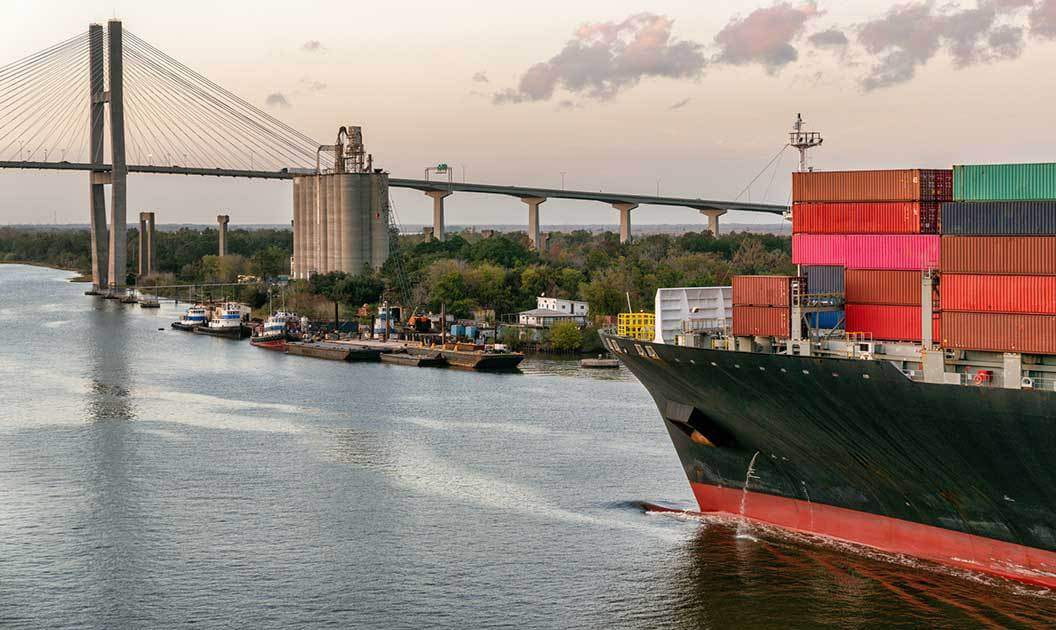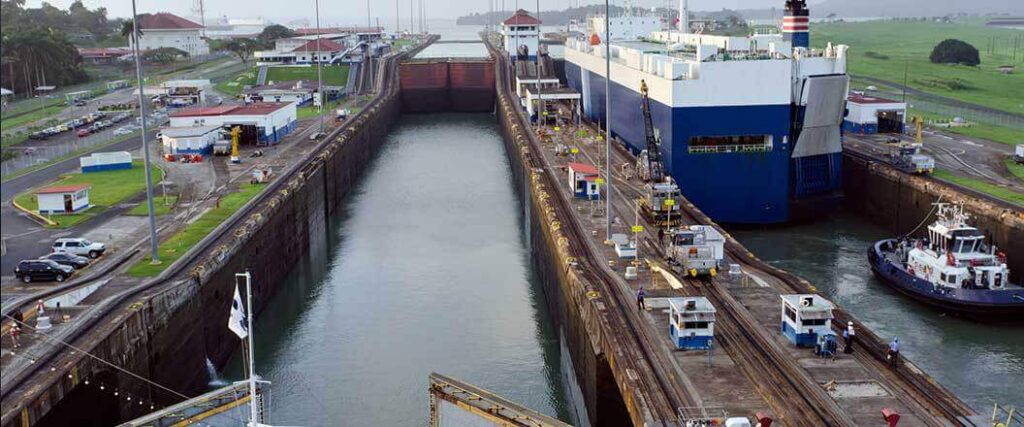
As surprising as it might seem, there are many types of container ships that are used to transport freight across the ocean and through canals and straights. All container vessels share a relatively similar ship design and, depending on their size, are able to transport conventionally shaped cargo.
The types of container vessels can be organized into four different families. The family of container vessels from small to large are:
Certain shipping routes require vessels of specific sizes. A vessel’s family group can let you know which specific routes the ship was designed to pass through.
We’ll go into the details of these types of container ships so you can know which one you’ll need to use when exporting or importing freight.

There are all kinds of different cargo vessels out on the open seas. There are many different variations, but the most recognizable is the cargo container vessel. With their varying sizes, these types of ships are the workhorse of the international shipping industry. Whether you’re importing or exporting, chances are you’ll need the help of one of these four types of vessels.
Vessels belonging to the feeder family can vary from small to medium-sized. The size variation of feeder ships is reflected in their varying classes. These classes from smallest to large are:
Certain types of cargo ships can sometimes be too large to enter a port to pick up freight. Feeder ships are used to resolve this problem. These vessels pick up freight from a port that’s too small for larger ships to dock, and it takes them a short distance to a central container terminal.
From there, the containers on the feeder are unloaded so that they can be put onto larger vessels that will transport them for the rest of the journey. Essentially, feeder ships are responsible for feeding their freight to larger vessels. Since feeder ships are used to transport freight to a larger vehicle, they tend to not travel that far.
The table below displays how many twenty-foot equivalent units (TEU) of freight each type of feeder ship can carry. Do note that these are averages, as precise TEU can vary by vessel.
| Small Feeders | 300 – 1,000 TEU |
| Feeders | 1,000 – 2,000 TEU |
| Feedermax | 2,000 – 3,000 TEU |
After feeder vessels come to the much larger cargo ships that transport freight much further distances.

Panamax vessels are a step above feeder’s vessels in size. Panamax ships are the largest vessels capable of passing through the Panama Canal. If you’re importing from or exporting to the Caribbean and Latin America, then this type of vessel is the one that you will need to use.
The Panama Canal makes it so that ships don’t have to round the tip of South America to travel from the west to east or vice versa. It provides direct passage between the Caribbean Sea and the Pacific Ocean.
Just like feeder vessels, Panamax vessels come in a few different classes of their own:
The post-Panamax was once a term that was given to vessels that were too large to fit through the narrowest parts of the Panama Canal. However, post-Panamax vessels can now traverse the Panama Canal thanks to an end of expansion efforts in 2016.
Some post-Panamax vessels that were once considered too large to pass through the Panama Canal can now travel through. Currently, new Panamax vessels are the designation given to vessels built to the specifications of the expanded canal. The TEU for each Panamax vessel is described in the table below.
| Panamax | 4,500 – 5,000 TEU |
| Post-Panamax | 12,000 – 20,000 TEU |
| New Panamax Vessels | 14,000 TEU |
Panamax vessels are fairly large, but they’re plenty of other cargo ships out there that can carry even more freight than them.

The next largest container vessel we’ll discuss is the Suez family of vessels. As their name implies, Suez container vessels are used to traverse the Suez Canal. Since the Suez Canal was created to facilitate an easier flow of trade between Europe and Asia, a Suez container ship is the vessel that you will need if to get freight to and from Asia if you’re shipping from the East Coast.
The Suez Canal provides a direct connection between the Mediterranean Sea to the Red Sea.
The Suez family of container vessels comes in a few different variations like the other ships we’ve discussed.
The Suezmax is a vessel that has been built specifically to fit within the Suez Canal. Unlike the Panama Canal, the Suez hasn’t gone under any expansion efforts. Therefore, any ships that do not fit in the Suez are considered post-Suezmax. In the table below, we’ve included the TEUs of Suezmax and post-Suezmax vessels.
| Suezmax | 10,000 – 12,000 TEU |
| Post-Suezmax | 16,000 – 18,000 TEU |
Suexmax vessels can carry a large quantity of freight, but they’re still not the largest type of container ship on the open seas.
The largest container vessels in use are the Malaccamax vessel. Like the Panamax and Suezmax vessels, the Malaccamax vessel gets its name from the body of water it’s designed to travel through, the Strait of Malacca. This strait allows trade between South East-Asian countries and Malaysia.
If you’re importing or exporting goods from these countries, chances are the route your shipment travels will go through Malacca. Unlike the previous vessels we’ve gone over, there is only one variety of Malaccamax vessels and that’s the post-Malaccamax. The TEU of a post-Malaccamax is 18,000 or more.
Access to different types of container vessels is one benefit of sending goods overseas. Read our article on ocean freight advantages to learn more about this shipping option.

Using a cargo container ship is useful for most varieties of freight shipments. Containers themselves come in slightly different sizes and dimensions that allow for the transportation of palletized and non-palletized dimensional types of freight.
The different types of shipping containers along with the amount of space that can be held within them vary.
| 20 Foot Container | 1,150 Cubic Feet | 5050 Pounds |
| 20 Foot High Container | 1,150 Cubic Feet | 5,180 Pounds |
| 40 Foot Container | 2,400 Cubic Feet | 8,000 Pounds |
| 40 Foot High Container | 2,400 Cubic Feet | 8,700 Pounds |
In addition to being able to hold standard-size freight, cargo containers can hold oversized freight as well. Using flat racks or platform containers, oversized freight can be loaded onto a cargo vessel. Even standard containers can transport consolidated oversized freight.
If you need to ship your goods fast, consider the advantages of air freight instead.

Shipping goods with container ships isn’t always a viable option, especially if you’re transporting bulk cargo or vehicles. Ships meant for hauling cargo containers aren’t suited for transporting these types of freight.
Fortunately, they’re other types of cargo ships that are designed to transport these types of freight such as:
Each of these vessels can compensate for the freight that regular cargo container ships can’t transport. Our article on the types of ocean freight shipping provide more in-depth details about these other services.
Freight forwarders are very beneficial when you have to move freight internationally. Many logistical challenges need to be considered and resolved when transporting freight extremely far distances. Doing so can be very difficult to do for an average shipper.
Freight forwarders rectify this problem by handling these responsibilities on behalf of the shipper. Since freight forwarders partner with a variety of carriers throughout the supply chain, they are able to book space on any of the container ships that we’ve already discussed.
All you have to do is specify where your goods are going to or from. A freight forwarder will also be able to negotiate a cheaper rate on your behalf. Our article on the benefits of using a freight forwarder will provide you with more information on how this service will help you.
Whether you need a Panamax, Suezmax or a Malaccamax, USA Freight Forwarding has got you covered. We have numerous connections with various carriers who have the right vessel for your freight shipment. If you’re looking for a means of shipping faster than ocean freight, we also offer international air shipping.
While you won’t be able to send off as much freight in one trip by air as you would by the ocean, you will be able to get what goods you do send off to their destination in a much shorter period.
Lastly, we offer consulting sessions to any shipper. During these consulting sessions, our freight forwarders can answer any question that you have about the shipping process. For more details about the services we provide, contact us at (866) 757-1109.
